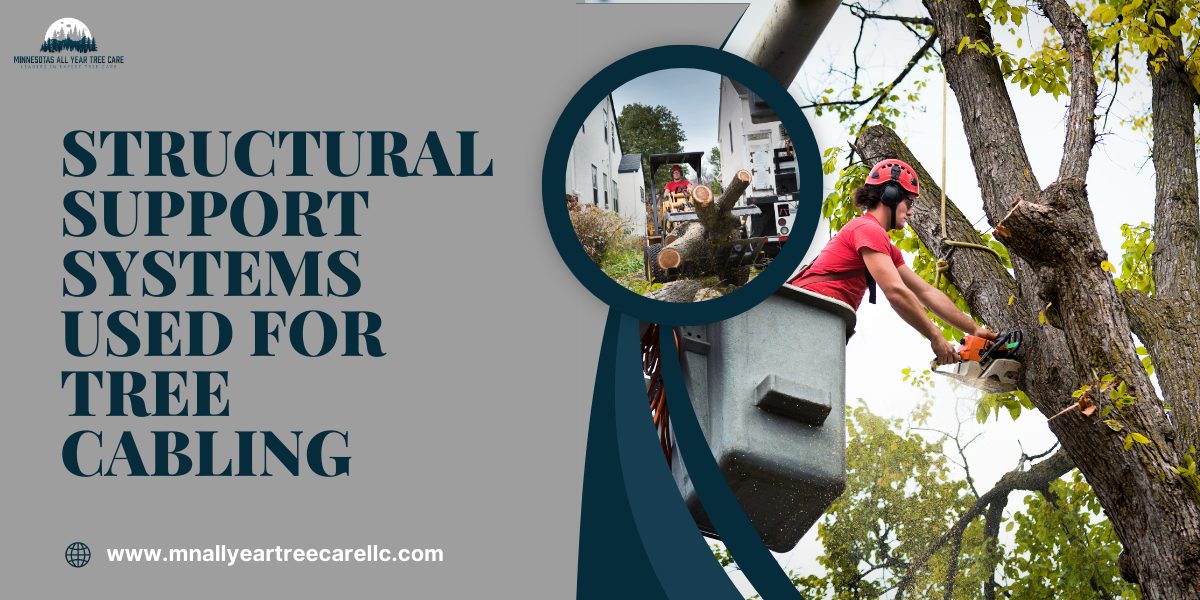When young trees are improperly pruned or trained, they may develop in ways that endanger their health and the security of nearby humans, animals, and structures. Arborists refer to this phenomenon as having several leaders or co-dominant leaders or stems, and more common in mature trees with two or more trunks. The same goes for trees with open canopies and horizontal or downward-growing limbs. Close planting in the nursery, insufficient root balls, root damage, planting in too-shallow holes, or planting in compacted soils can all result in newly planted trees having weak or unstable trunks. Tree support methods, such as tree cabling, bracing, and staking, may become effective treatments for structurally deficient trees. These support systems, when properly installed and maintained by certified arborists, can:
- Reduce the likelihood that a tree with co-dominant leaders will fail or have a weak trunk, limb, or other component.
- Extend the life of a valuable or ancient tree.
- Provide additional stability to newly transplanted trees while they develop supportive root systems.
Our expert arborists will examine your trees to identify structural flaws that could endanger the trees and the nearby property. Then, if further assistance is necessary to correct a structural issue, they will let you know and suggest the ideal kind of system for the tree.
Would Additional Support Systems Help Your Trees?
Professional arborists carefully consider their choices when erecting stakes, wires, or other devices for trees. These systems help the tree by restricting the movement of its leaders or vertical stems or adding additional support to the tree’s weaker points. However, the tree must also deal with the intrusion and limitations of this support hardware. Our arborists analyze the benefits and hazards to determine the best action for a sick tree. Additionally, they determine whether a tree needs to get removed if its condition is too bad for a support system to get used.
Tree support systems should only get installed by certified arborists. They get equipped with the knowledge and experience necessary to choose the best support strategy, the appropriate materials, and the least harmful installation methods for the system. Another crucial aspect is that an arborist can routinely check, modify, and maintain the system to maximize the advantages for your tree and minimize the danger to people and property.
Different Tree Support System Types
The most popular methods for preserving or enhancing a tree’s structural integrity get bracing and tree cabling. Less frequently utilized staking techniques are occasionally required to maintain a newly planted tree while it develops a strengthy root system.
Cabling
By limiting how far branches or co-dominant leaders can move in proportion to the remainder of the tree, cabling lowers the chance of breaking or splitting. Typically, the cables are positioned in the top crown or across a weak crotch (the joint at the base of two or more tree trunks or limbs). Traditional static tree cabling systems have a limited range of movement in the tree and get constructed with high-strength, durable steel wire and fittings. The “give” in dynamic cabling allows for more natural movement in the tree. Newer dynamic cabling systems get created from synthetic fabric rope and sling attachments. The system ideal for your tree and property can get decided by your arborist.

Bracing
Trees with several or co-dominant leaders often have bracing rods inserted to prevent occurring of splits or repair those that have already happened. Both “through-rod” braces, in which the rod is put through the trunk or branch and bolted with nuts on each side, and “dead-end” braces, in which the rod is threaded directly into the tree trunk or branch, are used to install the rigid braces through the union of the weak branches and stems. Bracing rods and cabling are used together to have the most robust support.
Staking
Staking is a support technique to straighten the trunk or maintain a tree upright and the root ball in place. A young tree can be staked by either tying stiff stakes or attaching three or four guys—wires or straps—to the tree and then securing the guys to the ground with stakes or other hardware.
In some situations, staking is beneficial. It is generally applied to a newly planted tree to provide additional support while it develops a powerful enough root system to stand alone. It’s possible that the tree’s weak root structure prevents it from supporting the wide spread of branches and leaves above it. Or perhaps the tree is situated in a very windy area where it is susceptible to being uprooted. Even older trees that have gotten harmed by weather might occasionally uproot. By staking them in the correct position and keeping them upright, you can encourage the regrowth of their root systems.
Our arborists only use staking when essential and for the shortest time, much like any other supplement support method. The longer the strapping devices are fastened to the tree, the greater the possibility of damage. Arborists also ensure the application allows some movement when staking a tree at risk. Why? Allowing a tree to sway in the wind encourages the development of vital structural fibers near the base of the trunk.
To find out more about our tree cabling and bracing services, get in touch with us.




